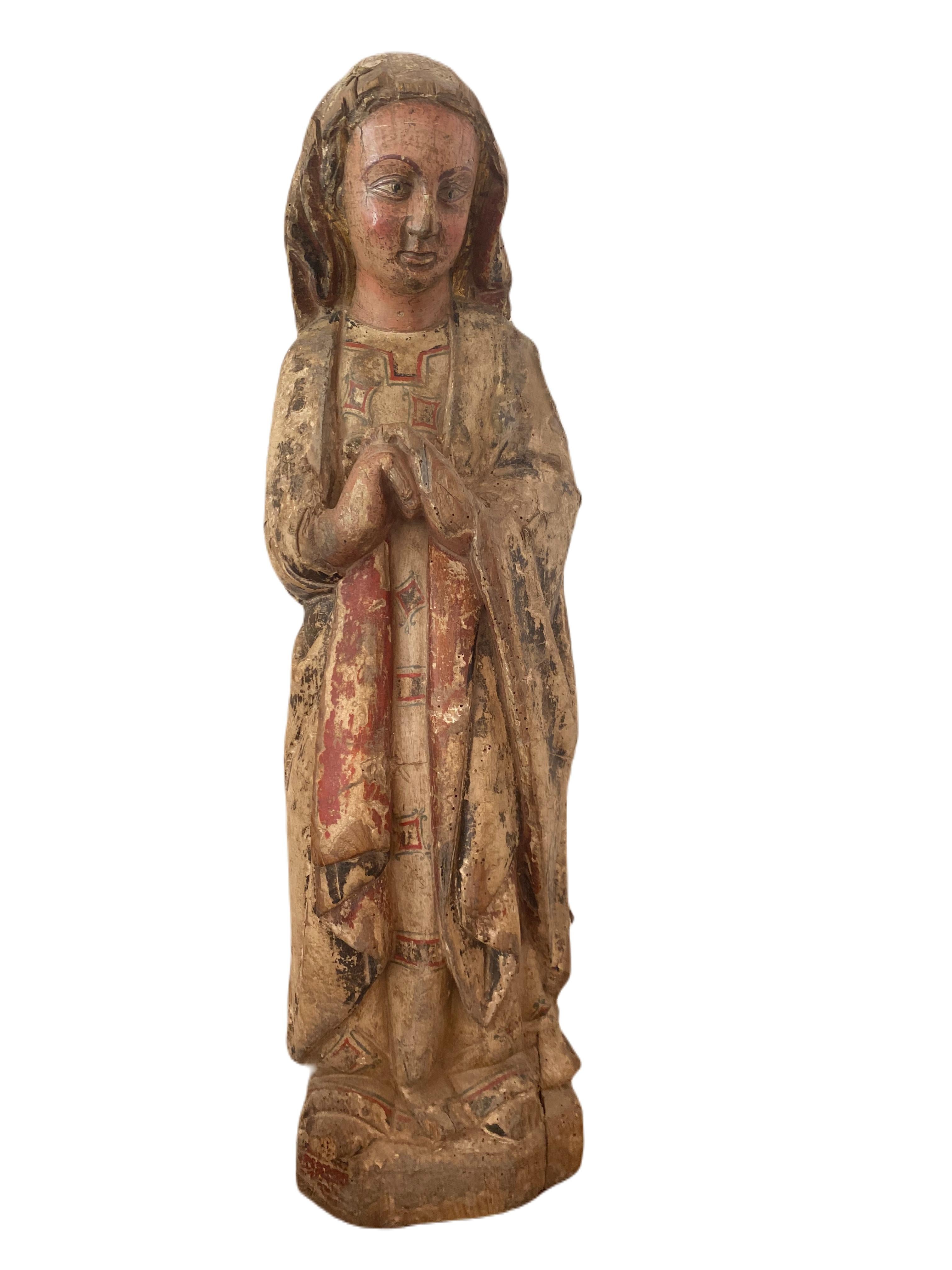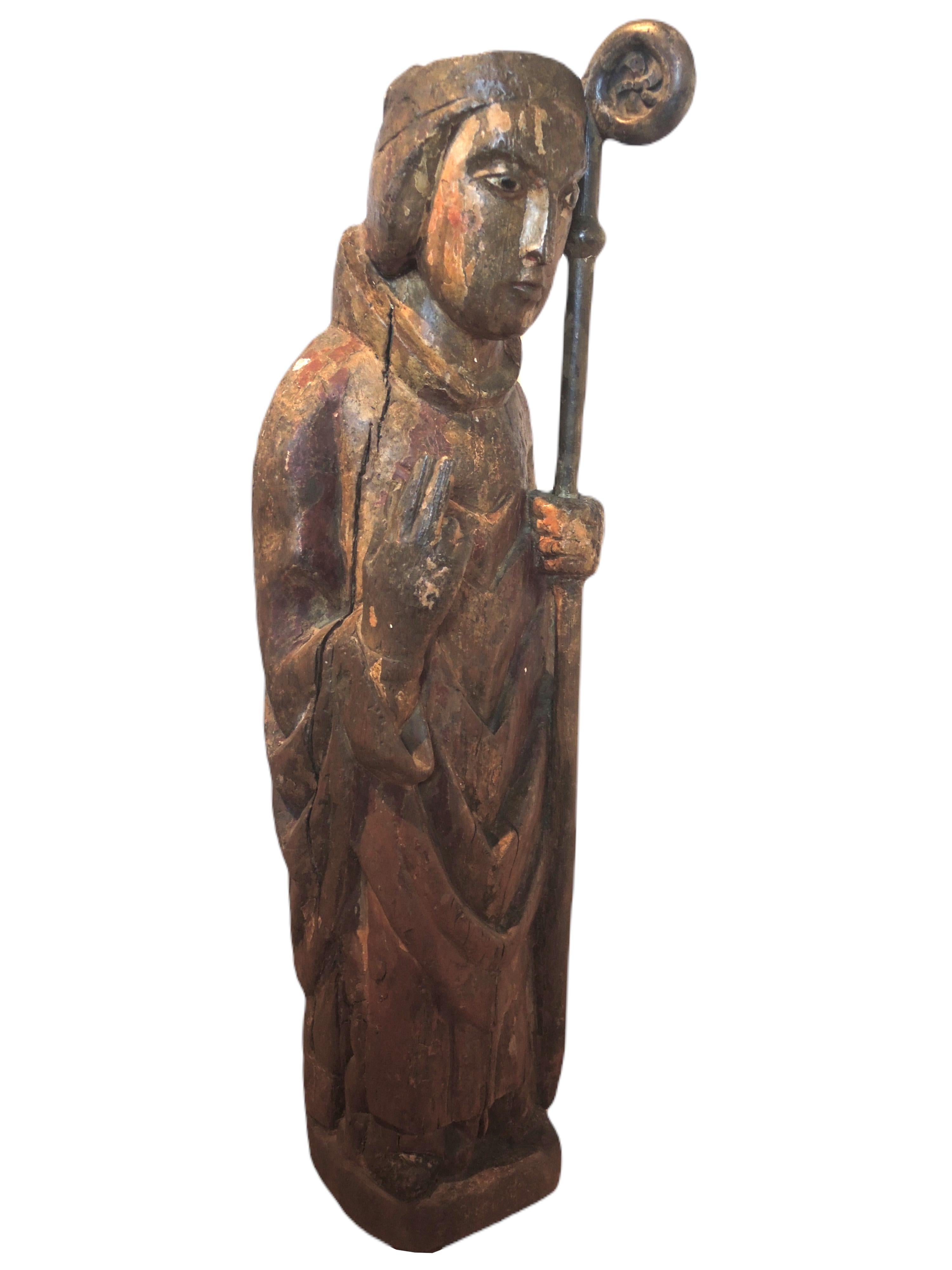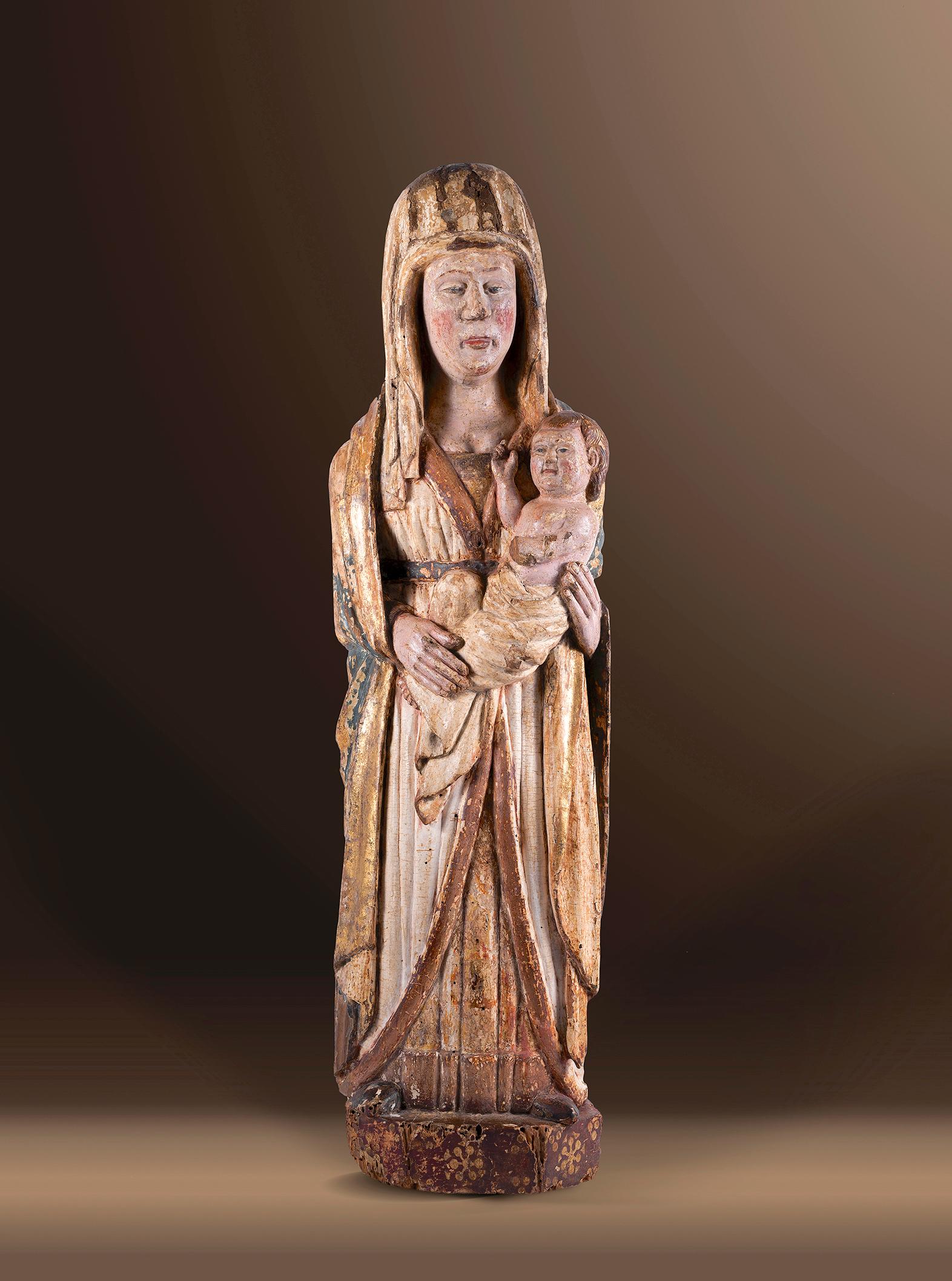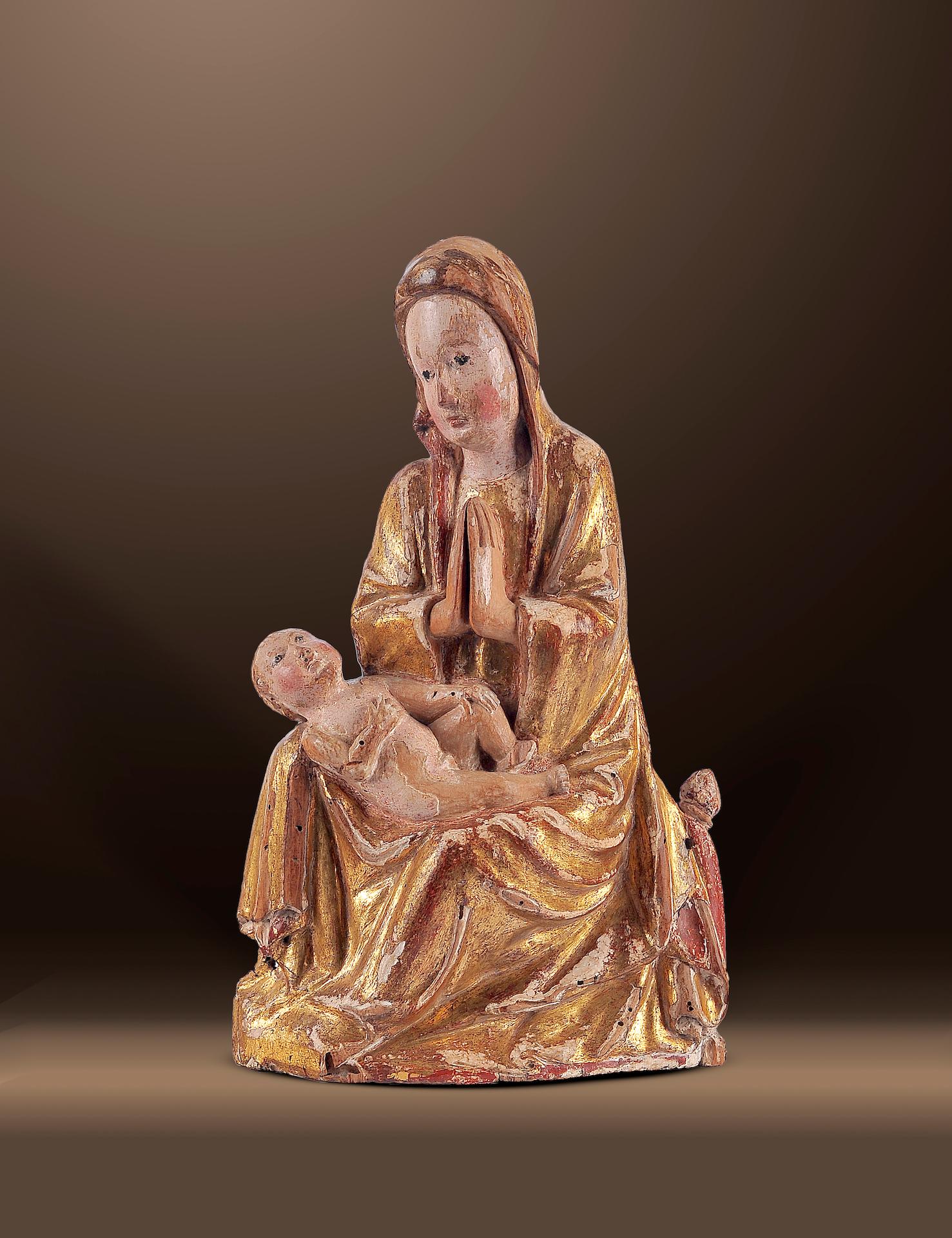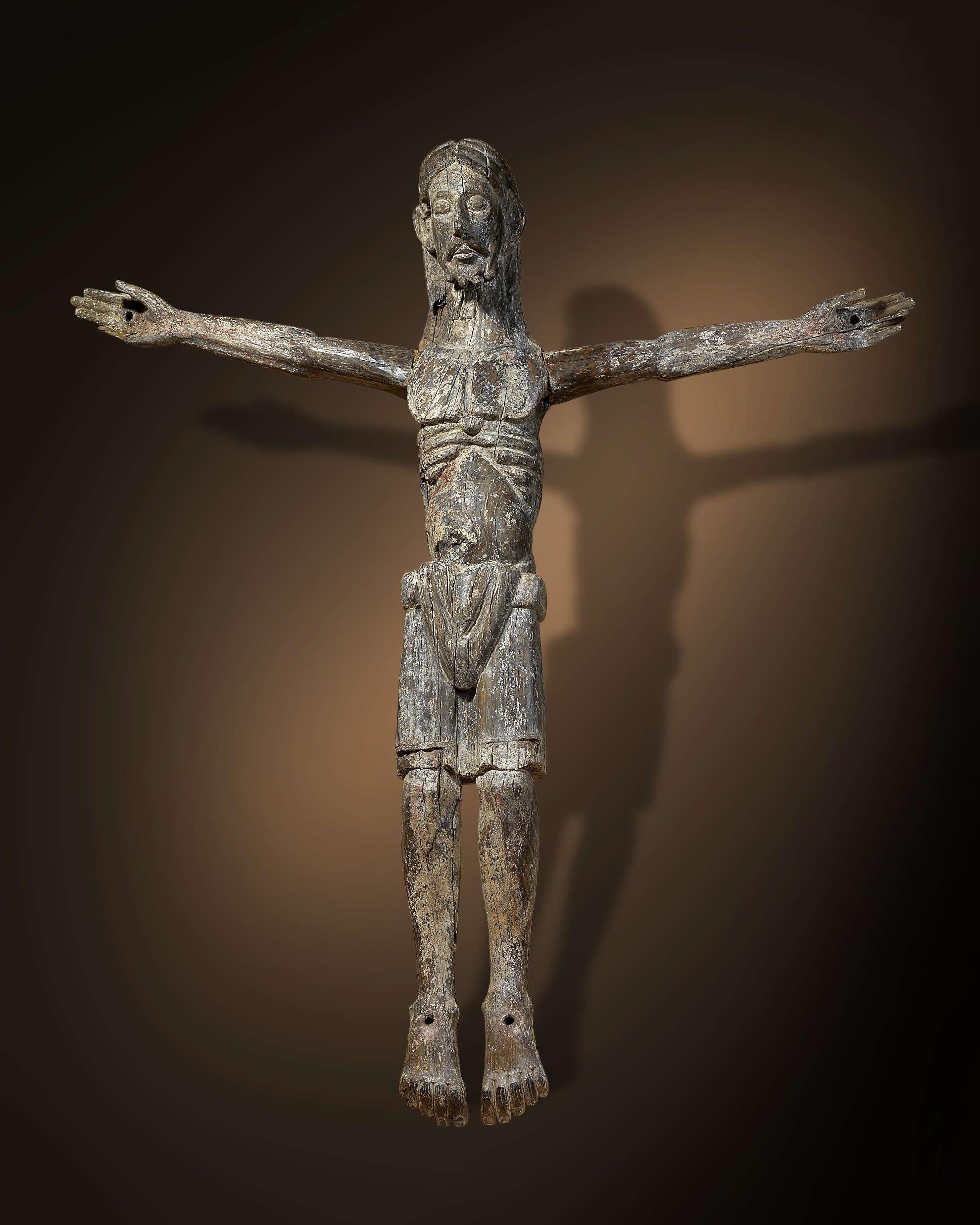Items Similar to Virgin of the Annunciation, Burgundy, early 15th century
Want more images or videos?
Request additional images or videos from the seller
1 of 15
Virgin of the Annunciation, Burgundy, early 15th century
About the Item
Virgin of the Annunciation
Burgundy, cercle of Claus de Werve (Haarlem? - Dijon, 1439)
Early 15th century
Walnut carved in the round
Hight: 60 cm
The Virgin Mary stands, her right hand placed on the chest in sign of deference, her other hand holding an open book between the pages of which she has slipped her index finger; broad face with slitted eyes, full cheeks and mouth with a pouty expression; she is dressed in a dress with a simple neckline and a veil-coat, a large section of which comes back to the front, probably hanging from her belt; deep and supple folds, layered under the left arm, thick and slightly arched at the back.
This delicate virgin takes us directly back to the most radiant period of Burgundian art. Small-scale sculpture takes on a particular importance in this region in full cultural and economic turmoil. The elements or groups of altarpieces, the mourners or independent statues, the influence of Flemish art emerges in the artistic movement which develops around two great sculptors: Claus de Sluter (Haarlem, 1355 - Dijon, 1406) and his nephew Claus de Werve (Haarlem? - Dijon, 1439).
Flamboyant Gothic is reflected here in the sinuous lines and twists that the figures take while their heavy, ample drapes unfold in large rolls.
The theme of the Annunciation is the favorite subject of the private chapels of castles. The angel of the Annunciation must have matched our Virgin's collected expression. Our sculpture undoubtedly belongs to Burgundian production from the beginning of the 15th century, still strongly influenced by the great Claus Sluter, whose style was continued by his nephew Claus de Werve. Thus, the very original attitude of our Virgin, presenting the book, the reading of which she had interrupted, completely open against her right hip, is a repeat of that of mourner no. 5, part of the procession to the tomb of the Duke of Burgundy, Philippe le Bold. Claus de Werve indeed contributed to this first tomb which was built between 1384 and 1410 and completed the project following the death of his uncle. We also find the physiognomy of the faces, typical of this school, like the style of the drapes, heavy and supple, the veil-coat directly borrowed from the mourner's costume.
Related works:
- Virgin and Saint John from the church of Prémaux, wood, h. 58 cm, workshop of Claus de Werve
- Virgin of the church of Flavigny sur Ozerain, h. 68 cm, workshop of Claus de Werve
- Saint Jean of the church of Flavigny sur Ozerain, Piasa sale June 7, 2013, workshop of Claus de Werve
Bibliography:
- Jacques Baudoin, La sculpture flamboyante en Bourgogne et Franche-Comté, edition: Créer, 1996
- Dimensions:Height: 23.62 in (60 cm)Width: 9.84 in (25 cm)
- Medium:
- Movement & Style:
- Circle Of:Claus de Werve (Dutch)
- Period:
- Condition:
- Gallery Location:PARIS, FR
- Reference Number:1stDibs: LU2433214004942
About the Seller
No Reviews Yet
Vetted Seller
These experienced sellers undergo a comprehensive evaluation by our team of in-house experts.
1stDibs seller since 2023
- ShippingRetrieving quote...Ships From: PARIS, France
- Return PolicyA return for this item may be initiated within 3 days of delivery.
More From This SellerView All
- A late 17th Italian carved limewood figure of Mermaid, circle of Filippo ParodiLocated in PARIS, FRA late 17th c. Italian carved figure of Mermaid, Circle of Filippo Parodi (Genoa, 1630 – July 22, 1702) Dimensions: h. 29.13 in, w. 30.31 in, p. 18.9 in (at the base) Magnificent...Category
Late 17th Century Baroque Figurative Sculptures
MaterialsWood
- A 16th century Renaissance North Italian marble heads of two puttisLocated in PARIS, FRLovely pair of heads of small cherubs carved in white Carrara marble. The chubby faces adorned with admirable hair with abundant tight and deep curls with a quiff on the forehead. Th...Category
16th Century Renaissance Figurative Sculptures
MaterialsMarble
- Virgin with child, workshop of Pieter Coecke Van Aelst, 16th c. Flemish schoolLocated in PARIS, FRVirgin and Child Workshop of Pieter Coecke Van Aelst (Aelst, 1502- Brussels, 1550) 16th century Oil on oak panel Dimensions: panel: h. 71.5cm, W. 48.5 cm (28.15 in x 19.09 in) Later ...Category
16th Century Old Masters Figurative Paintings
MaterialsOak, Oil
- Ascension day in Venice by Louis de Caullery (1582-1621) 17th c. Flemish schoolLocated in PARIS, FRAscension Day in Venice 17th century Antwerp School Louis de Caullery (1582-1621) Oil on oak panel Dimensions: h. 12.8 in, w. 23.03 in (h. 32,5 cm, w. 58,5 c...Category
Early 17th Century Old Masters Landscape Paintings
MaterialsOil, Oak
- Landscape with figures, workshop of Paul Bril, Italian school 17th CenturyBy Paul BrilLocated in PARIS, FRIdyllic landscape with myhological story of Cephalus and Procris Early 17th century Italian school Workshop Of Paul Bril (Antwerp, 1554 - Roma, 1626) Oil on poplar panel: H. 28 cm (1...Category
Early 17th Century Old Masters Landscape Paintings
MaterialsOil, Poplar
- Rest on the Flight into Egypt - Attributed to Pieter Van Avont - 17th c. FlemishBy Pieter van AvontLocated in PARIS, FRRest during the Flight into Egypt - The Virgin and Child with St. John the Baptist and the angels in a Landscape. Attributed to Pieter Van Avont (1600-1652) 17th century Antwerp School, circa 1630 Oil on oak panel, Dimensions: h. 38 cm, w. 50 cm (14.96 in x 19.68 in) Flemish style frame in ebonized and moulded wood Framed: h. 56 cm, w. 68.5 cm (22.04 in. x 26.97 in.) In the heart of a lush wooded landscape, the Virgin with Jesus rests in a green clearing accompanied by Saint John the Baptist and the cherubs. Seated to the left of the composition, the Virgin Mary holds the Child on her lap; the little Saint John the Baptist wearing the camel-skin tunic (his attribute) stands before Jesus to exchange a few caresses. On the right, the couple of cherubs are playing with the lamb of Saint John the Baptist, bringing a jovial character to the scene. A pair of gardening putti on the left pick flowers to bring bouquets to the Virgin and Jesus. Spring flowers such as tulips, daffodils and anemones that grow abundantly around them and enrich the composition with their shimmering colors. A lush rose bush blooms to the left of the figures offering delicate roses. (The rose is the flower associated with the Virgin Mary, who is the "mystical rose," the one that does not bear the "thorn of sin") At the feet of the Virgin are bunches of grapes (symbol of the future passion of Christ) as well as apples (symbol of the original fall of Man but also of the Redemption in Christ) In the foreground we find a wicker basket filled in profusion with beautiful flowers and guinea pigs nibbling on the blades of grass. In a cleverly arranged disorder, these elements of the still life with their strong symbolic power accentuate the religious theme, but are also an opportunity for the artist to demonstrate his know-how in the still life genre that is gaining momentum in Antwerp. The landscape behind the figures consists of a large tree with a twisted trunk and a luminous opening to the horizon placed on the right. We see Saint Joseph arriving with a donkey, a small reminder from the artist that the composition is associated with the episode of Rest during the flight into Egypt. The calm expanse of this bucolic forest opening onto the luminous distance, with its profusion of symbolic flowers and fruits, is particularly suited to this sacred scene. The theme of Jesus' sacrifice and his tragic fate is mitigated by cherubs who play with innocence and carelessness in the face of the fragility of life symbolized by cut flowers. The great mastery of the painter is manifested by the finesse of the drawing enhanced by the delicacy in the application of the brushstrokes bringing a multitude of details. The richness of the whole is exacerbated thanks to the choice of colours, this varied palette is an undeniable asset of our work. The virtuosity of our artist lies in his versatility, as much concerned with the success of the landscape and flowers as with the modelling of his figures. The cherubs with their naked bodies are gracefully illuminated by warm colours with subtle shadows, while the still life is rendered with astonishing realism, both in the precision of the drawing and in the countless shades of the flowers. There are several compositions similar to ours, of which below are the closest versions: • Sale, Jean-Claude Anaf et Associés, Lyon, 08/02/1998, attributed to Pieter Van Avont, oil on panel, h. 48 cm, l. 71 cm (recorded on RKD n° 31451). Comment: identical composition, only St Joseph with the donkey is different) • Christie's New York sale, 29/01/1998, Pieter Van Avont, oil on copper, h. 23.8 cm, w. 24.8 cm • Dorotheum sale, Vienna, 25/04/2017, Pieter Van Avont and Jan Breughel II, oil on copper, h .26 cm, w. 39 cm • Hermitage Museum, Saint Petersburg, Russia, Pieter Van Avont, oil on panel, h. 50.5 cm, w. 71.7 cm Peter van Avont, Flemish painter (Mechelen, 1600 - Antwerp. 1652) Born in Mechelen, he is mentioned in 1620 as a member of the painters' guild of his hometown. He left in 1 622 for Antwerp, where he was also a member of the guild. He collaborated with many painters, including Jan Brueguel the Younger, David Vinckboons, Lucas van Uden...Category
17th Century Old Masters Landscape Paintings
MaterialsOak, Oil
You May Also Like
- Polychrome Virgin of the Annunciation - CataloniaLocated in PARIS, FRLarge catalan Virgin of the Annunciation in polychrome wood. Our Virgin is represented in the phase of the Conturbatio, Mary expresses her amazement a...Category
15th Century and Earlier Gothic Figurative Sculptures
MaterialsWood
- Catalan School of the 13th century. Wooden BishopLocated in PARIS, FRCatalan School of the 13th century. Bishop statue in polychrome wood. Large polychrome wooden statue representing a holy bishop carrying a crosier and ma...Category
15th Century and Earlier Medieval Figurative Sculptures
MaterialsWood
- Late Gotic Relief "Adoration of the Magi"Located in Wien, WienLATE GOTIC RELIEF “Adoration of the Magi Lower Rhine Around 1500 Oak wood, plastically carved Original, polychrome version Height 51 cm, widt...Category
16th Century Gothic Figurative Sculptures
MaterialsWood, Oak
- Madonna around 1300Located in Wien, WienEXTREMELY RARE MADONNA Lake Constance area Around 1300 Carved votive wood Original, polychrome version Height 59 cm Provenance: Swiss private collection This Madonna figure ...Category
15th Century and Earlier Gothic Figurative Sculptures
MaterialsWood
- Sitting MadonnaLocated in Wien, WienSitting Madonna Central Italy/Tuscany or Marche Around 1420 Poplar wood carved Original version Height 31 cm Charming Madonna sculpture from the heyday of the Soft or International...Category
15th Century and Earlier Gothic Figurative Sculptures
MaterialsWood
- Corpus Christi 1150/70Located in Wien, WienCorpus Christi around 1150/70 Southern France or Catalonia carved oak wood height 109 cm, width 96 cm Remains of polychromyCategory
15th Century and Earlier Gothic Figurative Sculptures
MaterialsWood
